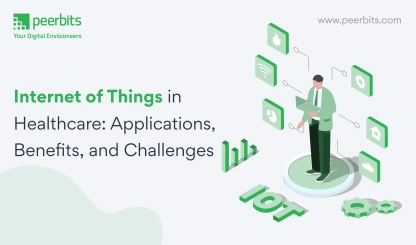Tracking and managing physical assets across multiple locations has become a serious challenge for businesses today. Whether you're overseeing warehouse stock, field equipment, or delivery vehicles, the need for accurate, real-time visibility is more important than ever.
This is where an asset tracking beacon becomes a practical and reliable solution. These small, Bluetooth-powered devices help you locate, monitor, and manage assets with high precision.
When combined with GPS, IoT, and smart software platforms, they improve operational control and reduce losses across your supply chain.
For companies investing in IoT application development services or upgrading their warehouse management software, adding beacon technology into your tracking strategy can bring measurable improvements.
In this blog, you'll learn how asset tracking beacons works, where it fits in modern businesses, and how it supports scalable, efficient asset management.
What is a beacon technology?
Just think of a lighthouse…
It sits high up on a hill and sends out a signal for all the boats at sea to see. It is repeatedly transmitting that single signal for everyone to see to advise of how far they are from land.
Well, a beacon is very similar to this…
A beacon is a small Bluetooth radio transmitter. They are very small and simple devices which house a CPU, radio, and a few small, lithium chip batteries. Or, sometimes, they run via connected power such as a USB plug.
The device comes in various shapes and colors and might include temperature sensors, accelerometers, or other unique add-ons. However, all beacons have one thing in common – their job is to transmit a signal, just like the lighthouse.
But, instead of emitting visible light, it transmits a radio signal composed of a combination of numbers and letters. And, this combination is transmitted at regular intervals of approximately 1/10th of a second.
What is the importance of a beacon tech?
So, just why are these small, message transmitting, Bluetooth devices valuable?
Well, they basically help improve the effectiveness of a company’s app or message. They are primarily used as a form of marketing.
For example, my iPhone knows where my home address is. So, I might be out at the store grabbing groceries, get back out to my car, and the Maps app will pop up a notification that it will take me 5 minutes to get home and I can simply click the notification for directions…
I guess they just assume I have forgotten my way?
Anyhow, this then encourages me to use the app.
This same idea is referenced in the example at the beginning of this article–it is commonly used to trigger a coupon or some sort of actionable message when the shopper is close to that specific store or mall.
It goes something like this:
A shopping mall installs beacons in their shop and each beacon will have a certain ID that is registered in their designated app. So, thanks to this registration, a smartphone app can immediately recognize the importance of the incoming ID from the beacon.
The smartphone then realizes that it is from that particular mall. But, other than that, the message has little meaning on its own… What happens next is entirely up to the IoT app development or other program used to recognize what it means.
So, how does it recognize what this code means?
The owner simply programs the app to read the code and trigger whatever action it deems – i.e. send a coupon. To break it down: Once the beacon simply connects to your exact location, the possibilities of what the program can do are endless.
For example, Microsoft’s SQL Beacon watches over your databases 24 hours a day. It monitors SQL Servers across an entire organization from a single instance – allowing DBAs to totally forget about best practice checks they often don’t have time to carry out.
Why do you need beacons for asset tracking?
Data-driven insights
If your business depends on physical assets across warehouses, vehicles, or field locations, keeping track of them in real time can be challenging. Manual tracking often leads to delays, losses, and unnecessary operational costs. Here’s why businesses are turning to beacon tracking systems:
-
Real-time visibility Beacons send regular signals to nearby receivers, giving you real-time updates on asset location and movement across the facility.
-
Seamless integration Beacons work well with asset management software and inventory tracking systems, helping you automate logs and reduce manual errors.
-
Improved efficiency
Faster audits, fewer misplaced items, and optimized workflows a time-saver for operations teams.
- Scalability and flexibility
Whether you manage one site or several, beacons can scale with your system and integrate with tools like GPS vehicle tracking or warehouse management software.
- Data-driven insights
Beacon data supports smarter planning by revealing asset usage trends, bottlenecks, and movement patterns.
- IoT-ready infrastructure
With custom IoT application development services, your beacon network can connect to cloud dashboards, mobile apps, and broader systems like Asset Tracking with RFID and IoT.
Choosing the right asset tracking solution built around beacons helps reduce risk, improve resource planning, and boost productivity across departments.
How beacons improve asset tracking & management?
Beacon asset tracking is an advanced and productive way of tracking. It can help in multiple ways. Firstly you can use fixed location-based beacons for asset tracking.
They generate different ID and Bluetooth-enabled devices. Secondly, you can use a moving tracker that also produces BLE(Bluetooth low energy). Thus various devices will pick these signals.
The beacon asset tracking assists in hospital management. With the help of these, you can improve the use of medical devices and boost doctor performance by the definite location of the asset position.
Furthermore, you can also supervise the location of staff in real-time to minimize their time wastage.
It is also beneficial in manufacturing firms, you can boost the efficiency of workers by analyzing their movement. You can also focus on the movement of goods for best management.
With beacon asset tracking, you can easily handle all your assets and supervise your employee.
Advantages of beacons for asset tracking
Beacons offer a compact and reliable solution to track assets within enclosed environments, especially where GPS falls short. When paired with an inventory management solution or warehouse management software, their efficiency multiplies. Here’s why they work well:
- Accurate indoor tracking
Unlike GPS, which isn’t reliable indoors, beacons provide consistent signals in warehouses, factories, and storage areas, making them perfect for indoor environments.
- Low maintenance
Beacons consume very little power, running on battery for long periods without needing frequent attention.
- Cost-effective at scale
Beacons are affordable to deploy across large areas, which makes them a practical fit for businesses managing thousands of items.
- Real-time asset visibility
Integrated with a warehouse management software, beacons can offer real-time updates on asset location and movement, helping reduce misplacement or delays.
- Smooth mobile integration
Beacons work with Bluetooth-enabled apps, allowing staff to track and locate assets directly from their smartphones or tablets.
- Better asset planning
When linked with an inventory management solution, beacon data helps track asset utilization, idle time, and bottlenecks supporting smarter inventory decisions.
Beacon industry statistics & market trends
It has become increasingly evident that beacons can be used in far more areas than just retail…
Specifically, beacons can be used to speed up the process of tracking and managing assets while also eliminating some of the common mistakes made during the process.
See table here for reference on applications of beacons.
Tracking and managing your assets is one of the most valuable aspects of your business. Not doing so can result in lost equipment and incorrect data – which could ultimately be pricey for you and your company.
However, beacons could effectively be the communication system between your equipment and your data tracking system. For example, you could easily cover a large warehouse with beacons to monitor how many finished products are sent out each day.
Next, comes the management part. Using beacons, you could monitor parts and materials during your manufacturing process which can help avoid bottlenecks and unnecessary delays in the production line.
Furthermore, beacon technology could even be used to assign a specific team member to a task based on their proximity to the location of the task at hand.
According to Research and Markets, the global beacon market is witnessing steady growth, reflecting real-world adoption across industries. According to recent data, the market grew from USD 2.52 billion in 2024 to USD 2.91 billion in 2025, and it is projected to reach USD 6.14 billion by 2030, growing at a CAGR of 15.97%.
This upward trend highlights the increasing demand for beacon-enabled solutions in retail, GPS vehicle tracking - transport, asset tracking, and warehouse management software.
Conclusion
Beacon technology has quietly become a valuable tool for modern tracking systems, especially in indoor environments where traditional GPS signals don’t reach.
When integrated with inventory management solutions or warehouse management software, it supports real-time visibility, smoother operations, and smarter asset movement.
For transportation, pairing asset tracking beacons with an IoT based bus tracking system brings added precision and reliability. Schools and fleet operators can track vehicle movement, monitor stops, and communicate delays more effectively, improving both safety and coordination.
As businesses look for smarter ways to manage people and assets, beacons offer a flexible, cost-effective solution that fits into a variety of workflows from warehouses to school campuses. The steady growth in the beacon market signals strong potential for wider adoption in the coming years.
FAQs
Yes, beacons transmit signals via Bluetooth. They don’t require an internet connection to function but need a connected app or system to collect and interpret the signals.
Beacon data can be encrypted, and most modern systems allow role-based access. When used with secure mobile apps and backend platforms, they offer a reliable and safe way to manage asset and vehicle data.
Very little. Most beacons run on battery for months or even years. You may only need occasional battery checks or firmware updates, depending on usage.
On their own, beacons are better suited for short-range tracking. But when integrated into an IoT based bus tracking system, they can be used at bus stops, gates, or school entrances to confirm proximity or log check-ins.
GPS is best for outdoor, long-distance tracking. Beacons are ideal for short-range and indoor tracking. Many modern tracking systems combine both to cover more ground effectively.
Yes, though signal interference can happen in dense environments. Still, with proper placement and testing, beacon tracking works well even in warehouses with complex layouts.
Beacon signals are picked up by receivers or mobile apps, which send the data to your backend. That data can then be displayed or analyzed through your warehouse management dashboard.
Not always. There are ready-made platforms and SDKs that can help you integrate beacon functions into existing mobile or web apps with minimal effort.








